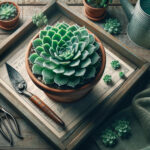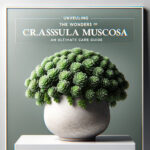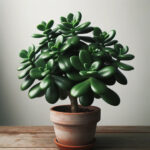So, you’ve been bitten by the succulent collecting bug, and now you’re on the hunt for your next green addition, right? Let me introduce you to the charming world of Crassula alba. Beloved by connoisseurs and novice collectors, this little gem of a plant has both character and resilience that cannot be ignored.
If Succulents Could Speak: The Unique Charm of Crassula alba
What makes the Crassula alba so unique? If plants could speak, this one would tell a thousand stories with its quirky, asymmetrical leaves and robust nature. The Crassula alba not only adds a pop of greenery to your space but also an element of exotic beauty. Each curve of its leaf, each shade of its green, expresses a visual language that only true plant enthusiasts would understand. And, don’t even get us started on those white flowers that burst out like mini fireworks – truly a sight to behold!
Crassula alba: The Celebrity Among Succulents
Perhaps you’re wondering, why does Crassula alba enjoy such popularity among succulent collectors? Picture this: you’re hosting a garden party, and your guests are awestruck by a seemingly humble yet captivating plant neatly sitting on your window sill. That’s right! It’s your Crassula alba stealing the show once again. Its ease of growth and maintenance, coupled with its unique features, make it a hot favorite among enthusiasts. Whether you’re a busy professional with little time for gardening or someone with the greenest thumb around, Crassula alba is sure to be a delightful addition to your plant family.
Bearing Witness to Nature’s Artistry with Crassula alba
Through this article, we delve into the fascinating world of Crassula alba up close and personal. You’ll discover how to ensure your Crassula alba thrives in your literal or metaphorical backyard. As verdant and unique as any Monet or Van Gogh, the Crassula alba proves that nature remains the finest artist, adding priceless aesthetic and emotion to our lives.
So before you rush to the nearest nursery or add that Crassula alba to your online shopping cart, let’s learn more about this diamond in the rough and how to take good care of it. Trust us, it’s going to be a fascinating journey!
If you’ve ever entertained the thought of cultivating a succulent collection, then you may have encountered or heard of the striking Crassula alba. This resilient and picturesque species has captured the hearts of indoor garden enthusiasts, and for a good reason. So, let’s inaugurate our exploration of the charming universe of Crassula alba.
Morphology of Crassula Alba
Characteristically, Crassula alba packs an impressive visual punch with its distinct morphology. It belongs to the family of Crassulaceae, known for their water storage capabilities. This succulent isn’t a waist-high monster; instead, it opts for a more subtle and compact size, with most plants reaching 8-12 inches in height.
Its robust tiny branches bear fleshy, rounded leaves which are organized in impressive spiralled arrays. The radiant green color of the leaves might mislead you into thinking it’s a high-maintenance plant, but don’t be fooled – it is as hardy as they come.
Features of the Crassula Alba
The Crassula alba is no shrinking violet. One of its most eye-catching features is its shape; imagine an upright, compact shrub that you can marvel at from a distance or appreciate up close in your indoor garden. As an added bonus, it blooms too! Yes, the Crassula alba presents a floral fiesta hard to ignore. Clusters of white, star-shaped flowers adorn the plant, usually during the late winter or early spring months.
These ethereal blooms, contrasted against its vibrant green foliage, creates a captivating aesthetic. This visual appeal, coupled with its low-maintenance nature, has made this succulent a favorite amongst both beginner and seasoned plant collectors.
Origin of Crassula Alba
The birthplace of the Crassula alba is the beautifully diverse southern regions of Africa. The species acclimatized quickly and survived in this new environment by storing water in its fleshy leaves and stems during periods of drought. Its resilience is truly commendable and allows it not to just survive, but to actually thrive in various climates and conditions.
While primarily found in nature, Crassula alba adapted remarkably well to cultivation and quickly found its way into the succulent collections of enthusiasts around the globe. Such a globetrotter and adapter, isn’t it?
In conclusion, Crassula alba is more than just an ornamental plant. Its resilience, low-maintenance nature, and captivating aesthetics make it a favorite amongst indoor garden connoisseurs. If you’re thinking of growing your own indoor garden, don’t forget to make a spot for the endearing Crassula alba.
If you’re looking to add a new green addition to your plant family, the charming Crassula alba might be the perfect fit. With its intricate, cream-colored blooms and crisp green succulent leaves, it’ll bring life to any space. But these beauties have their own specific set of needs. So, for your Crassula alba to attain its maximum potential, it’s crucial to ensure that its growing conditions are just right!
The Sun Kissed Crassula Alba
First off, let’s talk sunlight. Just like how we require sunlight for vitamin D, Crassula alba thrives with a good amount of sunbathing. However, it doesn’t appreciate harsh, direct sunlight – imagine having fun at the beach versus getting a sunburn. So, a spot that gets plenty of indirect sunlight or partial shade is ideal. An east or west-facing window would work splendidly!
The Thirst Schedule
Next up, watering. Now, if you’re someone prone to forgetting daily chores, this plant is pretty forgiving. Crassula alba holds moisture within its succulent leaves and prefers a bit of a dry spell over being drenched. Water the plant only when the soil is fully dry to the touch – think of a desert after a rainy storm. And avoid watering on the leaves directly as it can lead to rot. So, in terms of a watering schedule, you’re aiming for an “easy does it” approach!
Earthy Matters: The Ideal Soil for Crassula Alba
Finally, the ground below. A Crassula alba is quite the adaptable species but prefers well-draining soil. A cactus or succulent mix is usually a perfect choice, ensuring the roots don’t become waterlogged. If going the DIY route, you can try a mix of perlite and coarse sand with regular potting soil. Seeing your Crassula alba’s growth in this type of soil is much like relishing your favorite meal’s perfect flavor blend!
Mindfully ensuring these significant factors can create a hospitable environment for your Crassula alba. It might sound a bit meticulous, but remember – just as a good meal requires the right ingredients, your Crassula alba needs its specific conditions to flourish. Happy nurturing!
Have you ever thought of adding the Crassula alba, with its fascinatingly smooth, blue-green leaves and vibrant, crisp white flowers, to your plant collection? This step-by-step guide is going to help you understand how to best care for this stunning succulent so that it can flourish beautifully in your home or garden.
Step 1: Choosing the Right Pot
Proper potting is the first and one of the most vital steps in planting Crassula alba. Choose a container or pot that is wide and relatively shallow. It should have good drainage to prevent water from creating soggy conditions, which, let me tell you folks, this succulent certainly doesn’t appreciate. It’s like expecting you to wear wet socks all day – it’s not a pleasant situation!
Step 2: Choosing the Right Soil Mix
Ever tried baking a cake with the wrong ingredients? Similarly, with Crassula alba, great soil produce great results. This beautiful plant prefers well-draining soil, just like any succulent. A standard succulent or cactus mix works wonders, but you can even make your own mix with potting soil, perlite, and coarse sand. Remember, this isn’t stand on ceremony, so feel free to get a little messy!
Step 3: Positioning Your Crassula Alba
Here’s some insider info: Crassula alba loves love love sunlight! A sunny window will have your plant declaring its love for you in no time. That said, be careful about positioning it in too much direct sunlight, especially in warmer areas, as this can cause the leaves to scorch. Treat it like you’re introducing a new friend – don’t throw it directly into the limelight, let it warm up a bit and adjust to its new environment first.
Step 4: Initial Care Practices
Last but definitely not least, when it comes to giving your Crassula alba some TLC, watering is the key area to focus on. It’s like having a pet, you need to understand your plant’s needs and routines. Water it thoroughly and let it dry out completely before watering again. Be cautious of overwatering your new green friend, as it could lead to root rot or other nasty plant diseases.
In a nutshell, planting Crassula alba is a fun, rewarding experience that requires more love than it does hard work. With the right tools and techniques, you’re all set to help your Crassula alba shine bright and thrive.
Let’s dive into the nitty-gritty of caring for your Crassula alba to ensure it thrives, blooms, and remains healthy and vibrant. Just like any other plant baby, the Crassula alba, also known as the White Crassula, has specific needs, and understanding these will allow you to prevent any potential issues that might compromise the plant’s health.
Caring for Crassula alba: The Do’s
First up, let’s discuss what you absolutely should be doing when caring for your Crassula alba. Keeping these factors in mind will help your beautiful houseplant thrive with vigor and charm.
DO Provide Plenty of Sunlight
Being a succulent, the Crassula alba loves a good dose of sunlight. Remember how the plant basks in the morning sun in its natural habitat? Try mimicking that. Allow it to enjoy around four to six hours of indirect sunlight every day for optimal growth. Imagine it like you’re sunbathing, you love the warmth but don’t want to get burned. It’s the same with your Crassula alba. We don’t want to fry our lovely houseplants, do we?
DO Maintain Moderate Temperature
Just like you wouldn’t enjoy being stuck in either a very hot or very cold room, neither does the Crassula alba. It prefers temperatures between 65 – 75°F during the day and around 50°F at night. Be sure, especially with the cold spells, to keep your plant away from frosty windows or drafty spots.
DO Water Wisely
Despite being a resilient plant, your Crassula alba doesn’t want to sit in soggy soil. Over-watering, my friends, is a no-no. Water your Crassula alba deeply but only when the soil completely dries out, similar to a desert landscape after a rare rainfall.
Caring for Crassula alba: The Don’ts
Now moving onto what you shouldn’t do when caring for your Crassula alba. Avoiding these pitfalls can keep your plant from facing undue stress or damage.
DON’T Neglect Drainage
Just like no one likes a soggy sandwich, Crassula alba dislikes standing in water for prolonged periods. So ensure that your chosen pot has proper drainage holes. If the plant sits in water, it increases the risk of root rot, which can steal away your Crassula alba like a thief in the night!
DON’T Over-fertilize
Fertilizing a Crassula alba is helpful but remember, it’s not a glutton when it comes to nutrients. Too much of anything isn’t good, including plant food! Over-fertilizing can cause more harm than good, leading to a sickly-looking plant.
DON’T Ignore Pests
Your Crassula alba can unfortunately become a tasty treat for pests. Regularly inspect your plant like an inspector with a magnifying glass, looking for signs of pests, and take action swiftly to ensure your Crassula alba’s health isn’t compromised.
By following these do’s and don’ts, you’ll be well on your way to having not just a surviving, but thriving Crassula alba that will bring joy, beauty, and a slice of nature’s wonder into your comfortable home space.
Perks of Cultivating Crassula Alba
As an indoor gardener or a dedicated homeowner, having a Crassula alba grace your home or backyard comes with a plethora of appealing attributes. This striking succulent, with its compact fleshy leaves and alluring blooms, is not only a visual feast but goes beyond the aesthetic realm to offer incredible benefits.
An Alluring Aesthetics Enhancer
First and foremost, cultivating a Crassula alba equals having a living piece of art in your surroundings. With its attractive silvery-gray foliage and clusters of white or pink flowers that bloom in the colder months, it’s like having a perpetual painter’s palette redecorating your space. You might have tried throw pillows, framed artworks, or even an expensive rug to liven up your surroundings, but the captivating charm and simplicity that a Crassula alba brings is incomparable. This is illustration enough of the shared adage amongst botanists that “Crassula alba is nature’s aesthetics enhancer.”
Promoter of Positive Well-being
In the hustle-bustle of hectic modern lives, the serenity that comes from being surrounded by vibrant plants is priceless. Enter Crassula alba, a natural mood lifter right there on your desk or window sill. Not just a pretty face, its benefits go deeper impacting emotional well-being. Research has shown that being around plants can lower anxiety, improve concentration, and enhance overall satisfaction levels. Your little Crassula alba is not just eye candy; it’s working tirelessly to boost your mental well-being!
A Hardworking Air Purifier
While there’s no denying the aesthetic appeal that Crassula alba adds to your home or garden, this little powerhouse is also an efficient air purifier. Each Crassula alba in your home works as a mini air filtration system, removing toxins from the air and releasing fresh oxygen. It’s like having an army of little green soldiers tirelessly working round the clock to filter your air — free of cost!
When it comes to the merits of growing Crassula alba, the list just goes on. Whether it’s the vibrant aesthetics, rejuvenating vibes, or air-purifying benefits, there’s no ignoring the charms of this versatile little plant. So if you haven’t got a Crassula alba yet, it’s high time you did!
Dealing with Common Crassula Alba Problems
As a Crassula alba parent, things might not always go as smoothly as expected. Sometimes, your beloved plant may have a few hiccups along the way. But don’t sweat it! Most of these issues are common and can be fixed with a bit of knowledge, and the right care tactics. So, let’s dive into some of the most common ailments that might plague your Crassula alba, and explore the solutions.
Fungus in Crassula Alba
Have you noticed some unusual white fluffs on your Crassula alba, or perhaps some brown spots or patches on the leaves? Chances are, your plant might be dealing with a fungus problem. Often exacerbated by high humidity and overwatering, fungal disease can be detrimental if left unaddressed.
Firstly, reduce watering and increase air circulation around your Crassula alba. If this doesn’t help, you may need to resort to a commercial fungicide or a home remedy, such as a vinegar-water solution. Remember, the sooner you react to the symptoms, the better the chance your plant has of fully recovering.
Insect Infestation in Crassula Alba
Another common problem with Crassula alba is insect infestation. Mealybugs, spider mites, and scale insects could potentially choose your plant as a host. Signs of infestation can include honeydew (a sticky substance left by some pests), small white cotton-like clusters, or straight-up visible creepy crawlies.
In order to combat these unwelcome house guests, start with a gentle wipe-down of your Crassula alba using a cotton swab dipped in warm soapy water. For severe infestations, consider using an insecticidal soap or a neem oil solution.
Root Rot in Crassula Alba
Root rot is a nasty ailment that usually strikes when the plant has been overwatered, or the soil retains too much moisture. The soil gradually turns swampy, depriving the roots of much-needed oxygen, hence leading to decay. It’s one of the trickiest problems a plant can experience, but it’s not a death sentence for your Crassula alba.
Recognizing root rot early is key. If your Crassula alba’s leaves are yellowing or wilting despite sufficient watering, take a look at the roots. Difficult as it may be, if root rot is confirmed, you’ll need to remove the rotten roots carefully and repot the surviving plant in fresh, well-draining soil. And remember, prevention is better than cure, so keep a close check on your watering habits!
With a good understanding of these common ailments, and knowing how to tackle them, you’re well equipped to keep your Crassula alba happy, healthy and thriving. Growing Crassula alba can be a rewarding experience, and overcoming these little hurdles makes the journey even more fulfilling.
FAQs About Crassula Alba
Let’s dive right in to quench our thirst for knowledge about the fabulous Crassula Alba plant.
How often should I water my Crassula Alba?
You might be curious – how much water does this tiny succulent need? Just like other succulents, Crassula Alba thrives when watered sparingly. Generally, a good soaking once every two weeks should keep it happy. However, remember to adjust depending on the season and the pot’s moisture level. Never let the plant sit in a puddle of water, as this might cause root rot.
When does Crassula Alba bloom?
This unique succulent typically blooms around springtime or early summer. Its flowers are small and star-like, usually in clusters of pink or white. But remember, Crassula Alba only blooms if it gets enough sunlight – so don’t hide it away in a shaded corner of your home.
What common diseases should I watch out for?
Keep in mind; succulents can be prone to some diseases. Common issues with Crassula Alba include fungal diseases, aphids and mealybugs. If you notice anything unusual in your plant’s appearance or growth pattern, consult a plant care expert immediately.
How can I propagate my Crassula Alba plant?
Fancy sharing the Crassula Alba love with your friends? Great news! Propagation is relatively easy. You can propagate through stem cuttings or leaf cuttings – just let the cuttings dry for a day or two before planting. In a couple of weeks, you should see new little succulent babies sprouting up.
What are some unique features of Crassula Alba?
Crassula Alba is well known for its stunning, thick, paddle-shaped leaves that can range from deep green to pink hues. This succulent is compact and idyllic for indoor planting, but it’s the ability to tolerate neglect (to an extent) that really makes it stand out among other succulent varieties.
And there you have it, folks! With our answers to your Crassula Alba FAQs, you’re well-equipped to nurture this interesting plant. Whether you’re a novice plant enthusiast or an experienced green-thumb, we believe Crassula Alba brings a unique touch of nature to your space.



